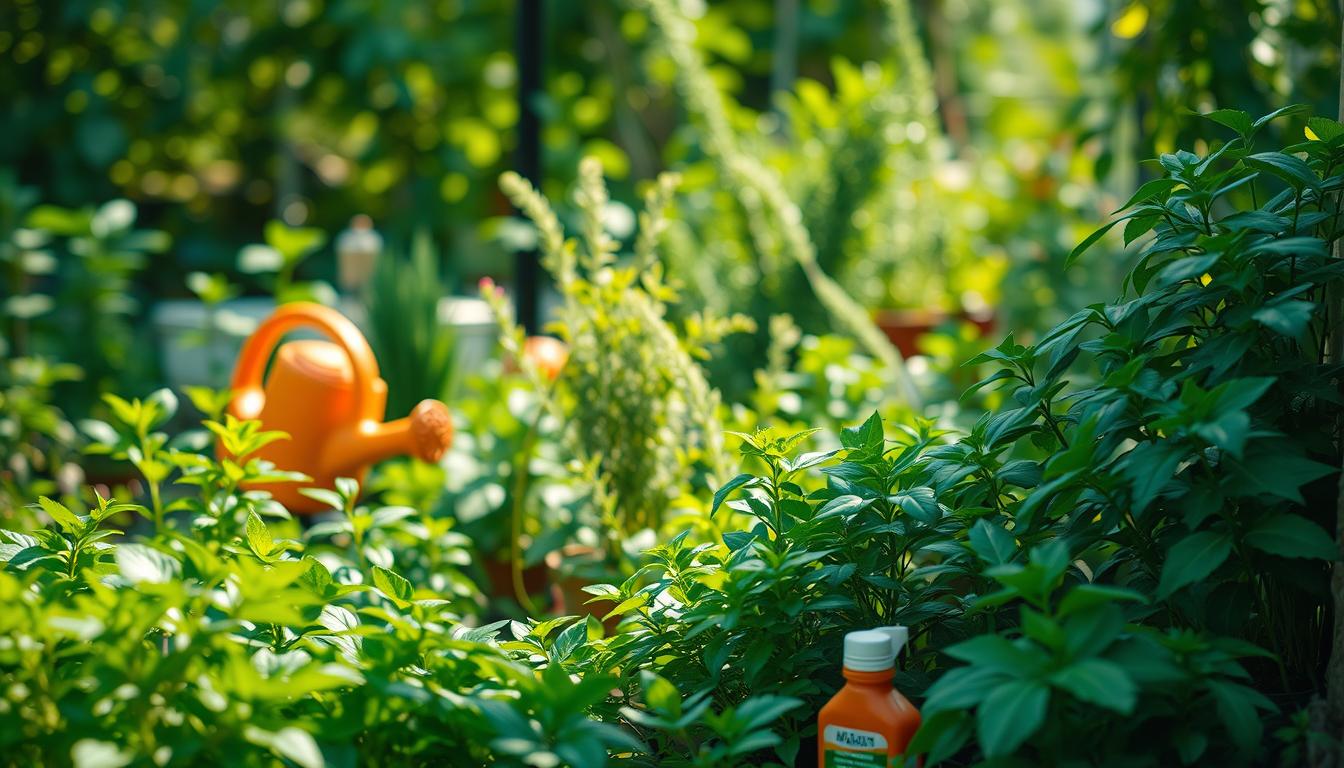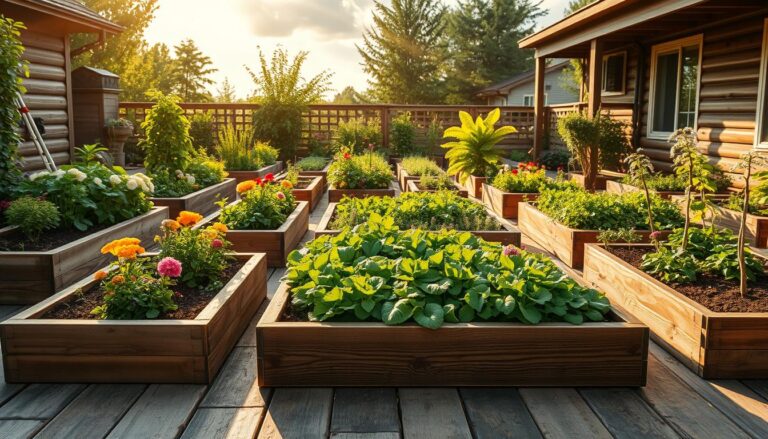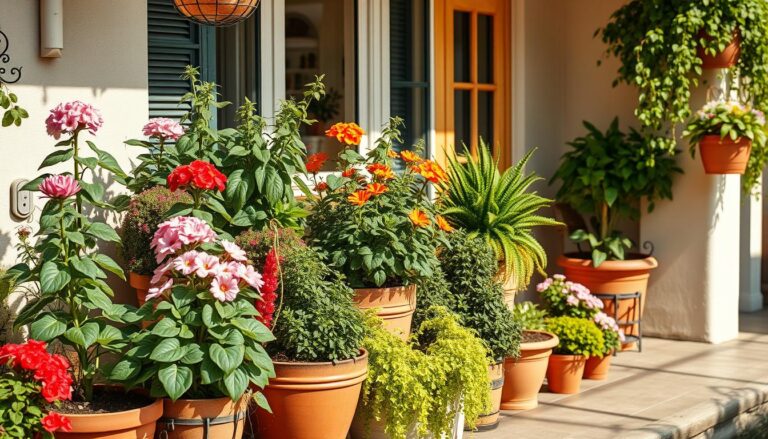Watering and Fertilizing Techniques: Unlock a Lush, Healthy Garden
This post contains affiliate links, meaning I may receive a small commission if you make a purchase through my links, at no extra cost to you.
Summer is here, and keeping your garden alive can be tough. The heat can cause plants to wilt and your garden to suffer. But, with some smart tips, you can keep your garden looking great all summer.
Using the right watering and fertilizing techniques can save your garden from summer’s harshness. It’s all about knowing what your plants need and adjusting your care plan. This way, you can enjoy a beautiful garden all season.
Key Takeaways
- Understand the importance of proper watering and fertilizing for a healthy garden
- Learn how to adjust your care routine according to the season
- Discover smart strategies for maintaining a lush garden during summer
- Find out how to protect your plants from drought stress and decline
- Explore the benefits of adopting the right watering and fertilizing techniques
Understanding the Basics of Plant Care
To grow a healthy garden, you must learn the basics of plant care. This includes knowing how important watering and fertilizing are for plant health.
Importance of Watering and Fertilizing
Watering and fertilizing are key parts of plant care. Proper watering techniques help plants get the nutrients they need. Fertilizing provides essential nutrients that the soil might lack. Learning these two skills can greatly improve your plants’ health and energy.
Gardening expert says,
“The key to a healthy garden lies in understanding the delicate balance between watering and fertilizing.”
Recognizing Plant Needs
Every plant has its own needs for watering and fertilizing. To give the best care, you must recognize the specific needs of your plants. This means knowing about soil type, climate, and the plant’s growth stage.
- Watch your plants closely to spot signs of nutrient lack or water stress.
- Change your watering and fertilizing routine as your plants’ needs change.
- Think about soil quality, sunlight, and temperature when caring for your plants.
Seasonal Plant Care Considerations
Plant care changes with the seasons. Seasonal changes bring new challenges and chances for gardeners. For instance, plants may need more water in hot summer months. In cooler spring months, they might need more nutrients for new growth.
- Change your watering schedule with the seasons, considering rainfall and temperature.
- Fertilize your plants during the growing season to help them grow well.
- Watch how your plants react to seasonal changes and adjust your care as needed.
The Science Behind Watering
Water is key for plant growth. It helps with photosynthesis, nutrient uptake, and cooling through transpiration.
How Water Affects Plant Growth
Deep watering helps plants grow strong roots. This makes them more resistant to drought. Watering in the morning lets plants dry before night, which fights fungal diseases.
When plants get enough water, they can take in more nutrients. This leads to healthier growth and development.
Different Watering Methods Explained
There are many ways to water plants, like drip irrigation, soaker hoses, and sprinklers. Each has its own benefits and drawbacks. For example, drip irrigation sends water straight to the roots, cutting down on evaporation and runoff.
Soaker hoses are great for raised garden beds.
Signs of Over and Under Watering
Too much water can cause root rot and nutrient shortages. Signs include yellow leaves, droopy stems, and soft roots. Not enough water stresses plants, slowing growth and productivity.
Signs of not enough water are wilted leaves, dry soil, and slow growth. Knowing these signs helps you adjust your watering. This keeps your garden healthy and thriving, including self-watering plants.
Understanding watering science and recognizing watering issues helps improve your gardening. This leads to a vibrant, healthy garden.
Essential Watering Techniques for Gardeners
Effective watering is key to a healthy garden. It’s simpler than you might think. By using the right methods, your plants will get the moisture they need to grow well.
Deep Watering Strategies
Deep watering is better than shallow watering. It helps roots grow deeper, making plants more drought-resistant. It also boosts root health, which is vital for your plants’ well-being.
To deep water, soak the soil 6-8 inches deep. Water slowly to let the soil absorb it fully. For hanging gardens or raised beds, make sure water spreads evenly without over or under watering.
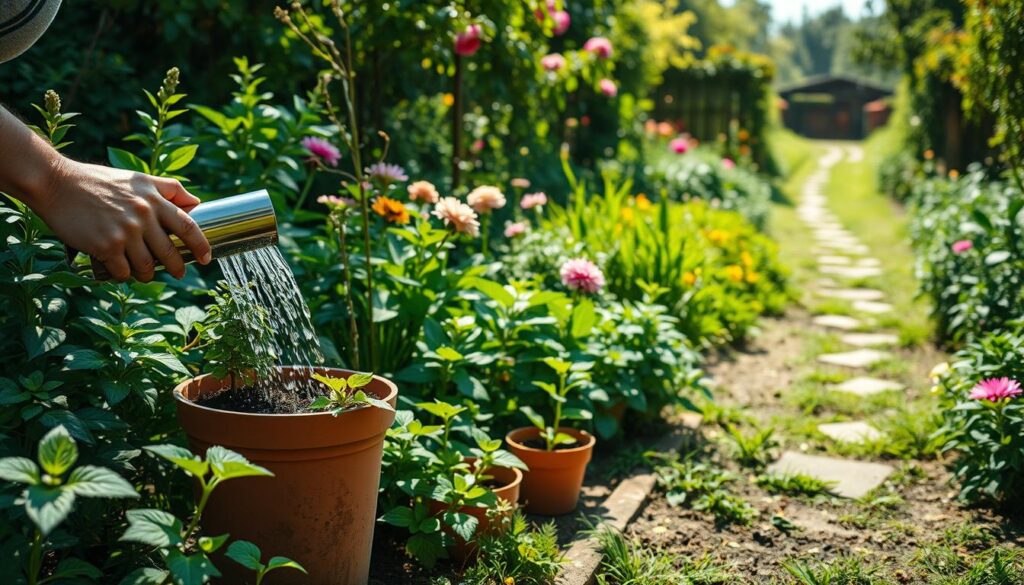
Frequency and Timing of Watering
Watering frequency and timing vary based on plant type, soil, and weather. Water in the morning or evening to reduce evaporation and ensure absorption.
Check soil moisture by feeling it with your finger. If it’s dry, it’s time to water. A moisture meter can also help gauge soil moisture.
| Plant Type | Watering Frequency | Soil Moisture Level |
|---|---|---|
| Vegetables | Daily | Consistently moist |
| Fruit Trees | Every other day | Moderately moist |
| Succulents | Weekly | Low moisture |
Using Soaker Hoses and Drip Irrigation
Soaker hoses and drip irrigation systems are great for watering plants efficiently. They reduce evaporation and runoff. Soaker hoses are perfect for watering raised garden beds as they provide consistent moisture.
Drip irrigation is best for plants needing precise watering, like vegetables and flowers. It delivers water directly to the roots, cutting down waste and promoting growth.
By using these essential watering techniques, you’ll have a lush, thriving garden. It will bring joy and beauty to your outdoor space.
Choosing the Right Fertilizers
The type of fertilizer you pick can really affect your garden’s health and output. There are many options out there. It’s key to know the differences to make a smart choice.
Understanding Organic vs. Synthetic Fertilizers
Fertilizers fall into two main groups: organic and synthetic. Organic fertilizers come from natural things like animal waste and seaweed. They’re popular with gardeners who like a natural way to garden. Synthetic fertilizers, made from chemicals, work faster but might harm the environment more.
When picking between organic and synthetic, think about your garden and the planet’s health. Organic options, like seaweed for potassium, bone meal for phosphorus, and feather meal for nitrogen, give a balanced feed to your garden.
| Fertilizer Type | Nutrient Source | Environmental Impact |
|---|---|---|
| Organic | Natural sources (e.g., seaweed, bone meal) | Generally lower |
| Synthetic | Chemical manufacturing | Potential for higher pollution |
Key Nutrients Every Plant Needs
Plants need different nutrients to grow well. The main ones are Nitrogen (N), Phosphorus (P), and Potassium (K), known as NPK. Nitrogen helps leaves grow, phosphorus roots, and potassium overall health.
Knowing the NPK ratio is key when picking a fertilizer. A 10-10-10 ratio is good for most gardens. But, some plants might need different ratios.
Reading and Interpreting Fertilizer Labels
Fertilizer labels tell you what’s in the product and how to use it. Look for the NPK ratio and any extra micronutrients. It’s also crucial to follow the application instructions to avoid harming your plants and the environment.
For instance, “10-10-10 NPK” means it has equal nitrogen, phosphorus, and potassium. Always pick a fertilizer that fits your garden’s needs.
Application Techniques for Fertilizers
To get the most out of your fertilizer, applying it correctly is key. The right application method and timing are as important as the fertilizer itself. Whether you make your own or buy it, how you apply it matters a lot.

How and When to Fertilize
When to fertilize is just as important as what to use. Spring and fall are the best times for most gardens. Spring helps plants bounce back from winter and grow new leaves. Fall gets them ready for the next year.
Lawns also benefit from spring and fall fertilization. It helps them deal with summer and winter stress.
Think about your plants’ needs when deciding how often to fertilize. Some plants need more food, especially if they grow a lot. Always check the fertilizer label for how often to use it.
Tips for Even Distribution
Evenly spreading fertilizer is key to avoid over- or under-fertilizing. Use a spreader for granular fertilizers. For liquids, a sprayer or watering can works best.
Divide your garden or lawn into sections for even application. Apply in a pattern like parallel lines or a crisscross to cover everything.
Avoiding Common Fertilizer Mistakes
One big mistake is over-fertilizing. Too much can harm plants by causing too much salt in the soil. This can burn roots. Always start with a small amount and follow the package instructions.
Not considering your soil type and pH is another error. Different soils need different fertilizers. Testing your soil helps choose the right one for your garden.
Combining Watering and Fertilizing
Effective watering and fertilizing are key to a great garden. When done right, your plants will be healthier, your foliage will be more vibrant, and your harvest will be bigger.
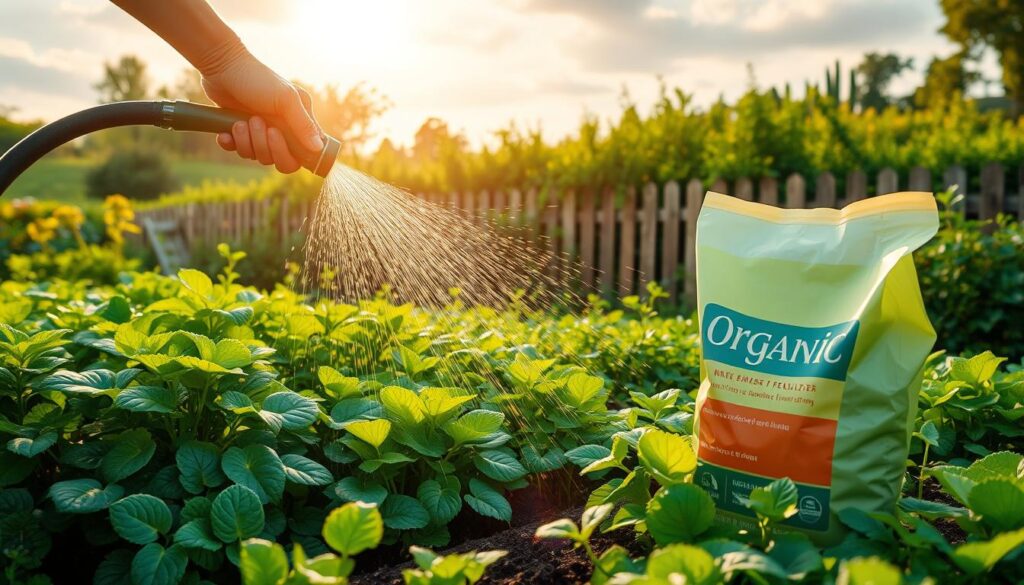
The Best Timing for Fertilization
The right time to fertilize depends on your plants, the weather, and the soil. Generally, fertilizing during the growing season is best. For many, this means spring and early summer. But, you need to know what your foliage plants need.
For growing plants, a balanced fertilizer with nitrogen, phosphorus, and potassium (NPK) is good. Choose the NPK ratio based on your plant’s needs. Some plants need more of one nutrient than others.
Watering After Fertilizer Application
After fertilizing, water your plants well. This helps the fertilizer dissolve and reach the roots. Watering thoroughly after fertilizing ensures nutrients are absorbed by the soil and made available to the plants. But, don’t overwater, as it can waste nutrients.
The way you water affects how well the fertilizer works. Drip irrigation is great because it waters the roots directly, reducing evaporation and runoff.
Benefits of Combining Both Techniques
Combining watering and fertilizing well brings many benefits. You’ll see healthier root development, more vibrant foliage, and better resistance to pests and diseases. This creates a perfect growing environment for your plants.
Using a natural plant fertilizer with a good watering schedule also improves soil quality. This makes your garden more sustainable, benefiting both your garden and the environment.
Addressing Soil Conditions
Soil quality is key to a healthy garden. Knowing its importance is vital for gardeners. The health of your plants depends on your soil’s condition.
Importance of Soil Quality
Soil quality is crucial for plant growth. It provides nutrients, water, and support. Healthy soil has many microorganisms that help plants grow.
To know what your soil needs, start with a soil test. Use a soil test kit to check nutrient levels and pH. This helps you choose the right amendments.
| Soil Characteristic | Ideal Range | Impact on Plants |
|---|---|---|
| pH Level | 6.0-7.0 | Affects nutrient availability |
| Nutrient Levels | Varies by nutrient | Impacts plant growth and health |
| Organic Matter | 5-10% | Supports beneficial microorganisms |
Techniques to Improve Soil Drainage
Good soil drainage is key to avoid waterlogged soil. This can cause root rot. Adding organic matter like compost helps.
It improves soil structure, letting water drain better. Soaker hoses or drip irrigation also help. They deliver water directly to the roots.
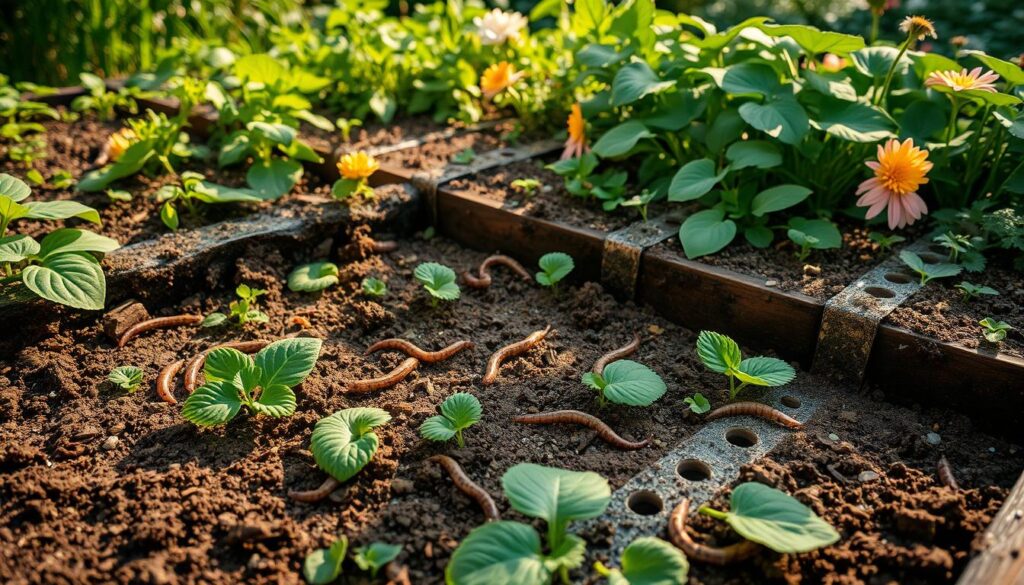
Testing Soil Nutrient Levels
Testing soil nutrient levels is essential. Use a soil testing kit to check nitrogen, phosphorus, and potassium. Adjust your fertilizer based on the results.
Understanding and improving your soil conditions helps your plants grow well. It’s not just about testing and amending. It’s about keeping your soil healthy for the long term.
Seasonal Considerations for Watering
As seasons change, your watering methods must too. Different plants need different amounts of water at different times. Knowing these needs is key to a healthy garden.
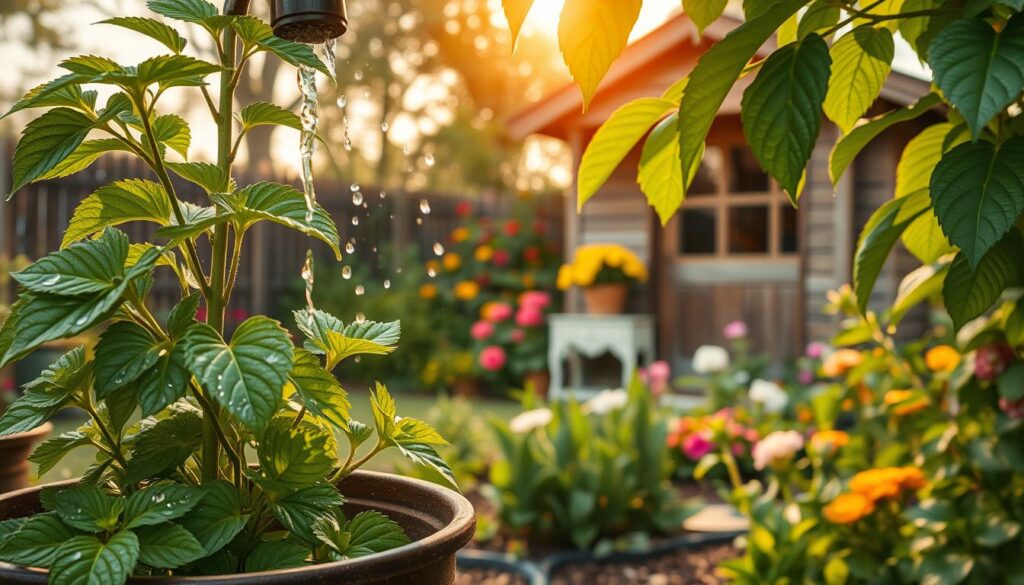
Adjusting Techniques for Different Seasons
In spring and summer, plants grow fast and need more water. But in fall and winter, they slow down and need less. For example, fall is great for making your lawn stronger before winter.
Change your watering schedule with the seasons. Water more in hot summer months and less in cool winter months.
Identifying Seasonal Planting Requirements
Knowing what plants need in each season is crucial. Some plants love certain conditions more than others. For instance, some need more water when they first start growing.
By knowing what plants need, you can plan your garden better. Choose plants that fit the season and water them right.
Watering During Extreme Heat or Cold
Extreme weather changes how much water your garden needs. In hot weather, plants need more water to stay hydrated. In cold weather, they need less to avoid soggy soil.
Tips for Watering During Extreme Weather:
- Check the soil moisture often to adjust your watering.
- Water when it’s cooler to avoid losing water to evaporation.
- Use mulch or other methods to keep the soil moist and warm.
By keeping these tips in mind, you can help your garden survive extreme weather. This keeps your garden healthy and strong.
DIY Fertilizer Options for Home Gardeners
Starting a sustainable garden is easy with homemade fertilizers. You can use kitchen scraps, make compost, and create liquid fertilizers. These methods help your garden grow without costing much or harming the environment.
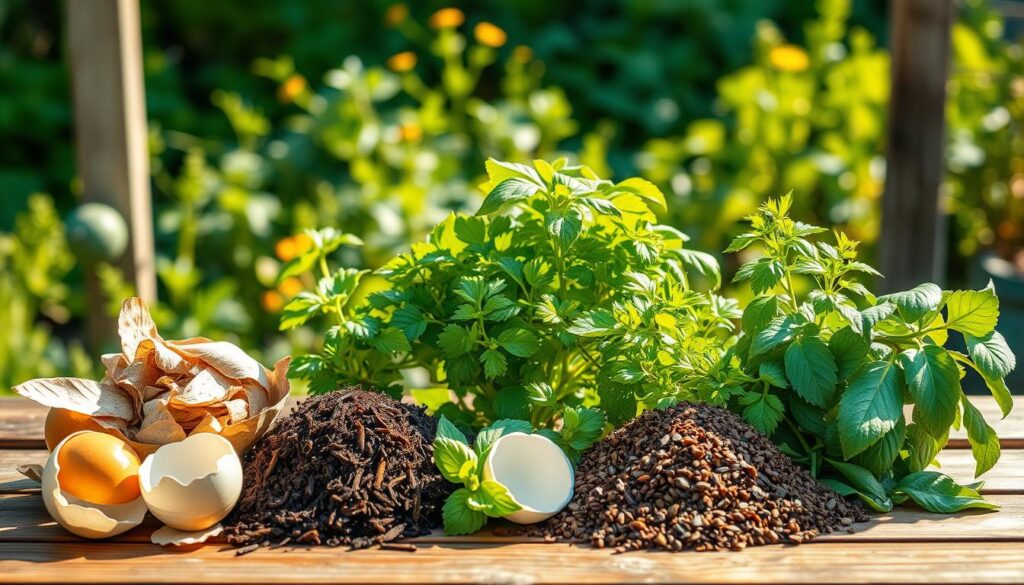
Kitchen Scraps as Natural Fertilizers
Kitchen scraps are great for your garden. Egg shells are full of calcium, which plants need to grow. Crush them and mix into the soil to prevent blossom end rot in tomatoes and veggies.
Banana peels are packed with potassium, good for plant health. Bury them around plants or mix into compost for a natural boost.
Coffee grounds and tea bags are also useful. Coffee grounds have nitrogen, phosphorus, and potassium, making them great for compost or soil. Tea bags add microbes to the soil as they break down.
Creating Compost for Nutrient-Rich Soil
Compost is key for organic lawn care. Start by collecting organic materials like kitchen scraps, leaves, and grass clippings. Mix “green” materials (like kitchen scraps) with “brown” materials (like dried leaves) in a compost bin. Turn the pile often to speed up decomposition.
A good compost pile makes soil rich and full of microbes. Spread a half-inch layer of compost on your lawn or garden beds. It adds organic matter and beneficial organisms to the soil.
- Collect kitchen scraps and other organic materials.
- Layer materials in a compost bin.
- Regularly turn the compost pile.
- Use the finished compost to enrich your soil.
Homemade Liquid Fertilizers and Their Uses
Liquid fertilizers give plants a quick nutrient boost. Steeping comfrey leaves in water is a simple recipe. Comfrey is full of nutrients, making it perfect for liquid fertilizers. Steep the leaves, then strain and use the liquid.
Another option is making manure tea by steeping animal manure in water. This liquid fertilizer is full of nutrients for healthy plant growth. Always dilute it with water before applying to avoid burning plant roots.
- Steep comfrey leaves or animal manure in water.
- Strain the liquid after a few weeks.
- Dilute the liquid fertilizer with water.
- Apply it to your plants for a nutrient boost.
Advanced Watering Techniques
Watering your garden right is crucial for its health. There are many ways to do this efficiently. These methods help save water, cut down on waste, and make plants grow better.
Utilizing Rain Barrels for Sustainable Watering
Using rain barrels is a great way to water your garden. They collect rainwater, giving your plants a natural, chemical-free drink. This not only saves water but also lessens the strain on city water supplies.
To start a rain barrel system, you need a few things. A big barrel to hold water, a way to catch rainwater from your roof, and a spigot for watering. Rainwater helps keep your local waterways clean by reducing stormwater pollution.
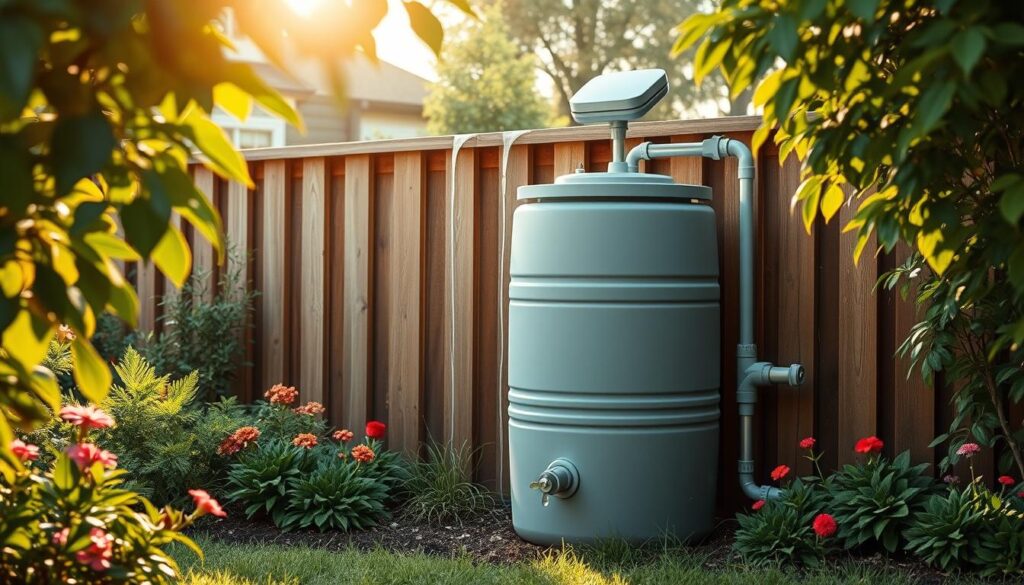
The Role of Automated Systems
Automated watering systems make watering easier and more efficient. They water your plants when they need it most, cutting down on waste. This ensures your plants get the right amount of water, helping them grow strong and healthy.
| Type of System | Benefits | Considerations |
|---|---|---|
| Drip Irrigation | Delivers water directly to roots, reducing evaporation | Initial setup cost, potential for clogging |
| Soaker Hoses | Provides slow, steady watering | Potential for water loss due to evaporation |
| Smart Controllers | Adjusts watering based on weather conditions | Requires internet connectivity, potential for technical issues |
Managing Water Use During Drought
When it’s dry, it’s important to use water wisely. Focus on watering plants that need it most. Mulch helps keep the soil moist, reducing water loss.
Choose plants that don’t need much water. These plants are made to survive with little water. They make your garden more water-friendly and strong.
Common Mistakes in Watering and Fertilizing
Creating a lush, healthy garden is a journey filled with good intentions. Yet, common mistakes can slow your progress. Watering and fertilizing are key to gardening success. Knowing the pitfalls can help you steer clear of costly errors.
Overwatering: Causes and Effects
Overwatering is a common mistake many gardeners make. It can harm plant roots and make lawns more prone to disease. A simple rule is to water only when the grass starts to turn brown. This ensures your plants get the right moisture without drowning.
Signs of Overwatering: Look for yellow leaves, soft stems, and a decline in plant health. Adjusting your watering schedule can fix these issues.
Misapplication of Fertilizers
Using fertilizers wrong can be as damaging as overwatering. It’s crucial to know the right fertilizer for your plants and how to apply it. Homestead garden fertilizer products can be helpful, but follow the manufacturer’s instructions.
Tips for Fertilizer Application: Always read the label and follow the recommended rates. Overfertilizing can harm plants and pollute soil and water.
Trying to “Fix” Nutrient Deficiency Without Testing
Trying to fix nutrient deficiencies without soil testing can cause more harm. Soil testing gives insights into nutrient levels and pH balance. This helps you make informed fertilizer choices.
“Soil testing is the first step towards a healthy and thriving garden. It helps you understand what your soil needs, rather than relying on guesswork.”
— Gardening Expert
Soil Testing Benefits: It identifies nutrient deficiencies and pH imbalances. It guides fertilizer application and improves soil health over time.
| Soil Test Results | Interpretation | Action |
|---|---|---|
| Low Nutrient Levels | Soil lacks essential nutrients | Apply appropriate fertilizers |
| pH Imbalance | Soil pH is too high or too low | Adjust soil pH accordingly |

Being aware of these common mistakes and avoiding them can lead to a sustainable, thriving garden. The key to a healthy garden is understanding your plants’ needs and taking informed actions.
Resources for Effective Plant Care
As you continue on your gardening journey, having the right resources can make all the difference. Whether you’re tending to a Dish Garden or nurturing a lush, organic lawn, it’s essential to stay informed and inspired.
For those looking to expand their knowledge, several recommended books and websites offer expert advice on watering and fertilizing techniques. You can also explore local gardening clubs and workshops, which provide hands-on experience and the opportunity to connect with fellow gardeners.
Recommended Books and Websites
Some top resources include online forums, gardening blogs, and educational websites that share tips and best practices for maintaining a healthy garden. You can also find books on specific topics, such as organic gardening and sustainable watering methods.
Local Gardening Clubs and Workshops
Joining a local gardening club or attending a workshop can be a great way to learn from experienced gardeners and get tips on improving your gardening skills. Many clubs also offer hands-on training and demonstrations.
Online Courses and Educational Videos
For those who prefer learning at their own pace, online courses and educational videos are available on various platforms. These resources cover a range of topics, from basic gardening techniques to advanced methods for optimizing plant care.
FAQ
What is the best way to water my Dish Garden?
To water your Dish Garden right, check the soil moisture. Stick your finger into the soil up to the first knuckle. If it’s dry, it’s time to water. Don’t overwater, as it can cause root rot and other issues.
How often should I fertilize my plants in a Rain Garden?
Fertilizing frequency varies based on your plants and soil. Fertilize once a month during the growing season. Use a balanced, water-soluble fertilizer to help your plants grow well.
Can I use a Hanging Garden with Self Watering Plants?
Yes, Self Watering Plants are great for Hanging Gardens. They have built-in water reservoirs. This means plants can get water as needed, reducing how often you need to water. It’s perfect for busy gardeners or those who forget to water.
How do I create a Recycled Garden?
To make a Recycled Garden, use old containers and plastic bottles. Get creative with items like old jars and bottles. You can turn them into planters and garden markers.
What is the best fertilizer for my Vegetable Garden?
The best fertilizer for your Vegetable Garden depends on your plants and soil. Start with a balanced fertilizer that has nitrogen, phosphorus, and potassium. Organic or homemade fertilizers from kitchen scraps or compost are also good options.
How do I Watering Raised Garden Beds effectively?
Water Raised Garden Beds well by using a soaker hose or drip irrigation. This method delivers water right to the roots. It cuts down on evaporation and runoff, ensuring your plants get enough water.
What are some Allotment Ideas for small gardens?
For small gardens, use vertical space and container gardening. Try companion planting and consider a keyhole or lasagna garden. These ideas help make the most of your space and reduce waste.
Can I make a Bottle Garden?
Yes, a Bottle Garden is a simple way to create a mini indoor garden. Just add soil, plants, and decorative rocks to a glass bottle. It’s a beautiful and easy-to-care-for garden.
How do I maintain an Indoor Water Garden?
Keep your Indoor Water Garden clean and clear. Make sure plants get the right nutrients. Regularly test the water quality and adjust as needed to keep your plants healthy.
What are some tips for Plant Care?
For good Plant Care, provide the right light, water, and nutrients. Prune and repot as needed. Check your plants for pests or diseases often and act quickly to prevent problems.
How do I identify Plant Deficiencies?
Look for signs like yellow leaves, stunted growth, or poor fruiting. Regularly check your plants. Adjust your fertilizing and watering to address any deficiencies.
What is Npk Fertilizer, and how do I use it?
Npk Fertilizer has nitrogen, phosphorus, and potassium. Follow the manufacturer’s instructions. Be careful not to overfertilize, as it can harm your plants.
How do I create Homemade Fertilizer For Plants?
Make Homemade Fertilizer by using kitchen scraps, compost, or natural materials. You can steep compost or manure in water for a liquid fertilizer. Or mix compost with other ingredients for a solid fertilizer.
What are some benefits of using Organic Fertilizer?
Organic Fertilizer promotes healthy soil biota and improves soil structure. It reduces chemical contamination risk. Organic fertilizers are eco-friendly and can be homemade using natural materials.
How do I care for Foliage Plants?
For Foliage Plants, provide the right light, water, and nutrients. Dust the leaves to keep them clean. Prune or repot as needed to maintain shape and size.
What is homestead garden fertilizer, and how do I use it?
Homestead garden fertilizer is made at home from natural materials like compost, manure, or kitchen scraps. Use it according to your plants’ needs, avoiding overfertilizing.

